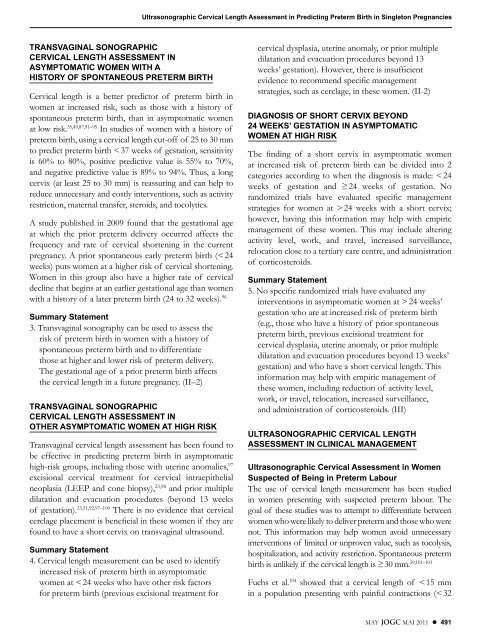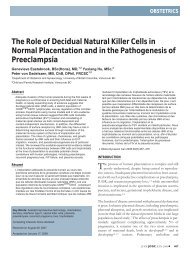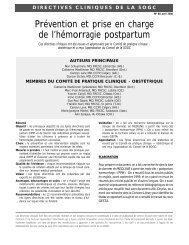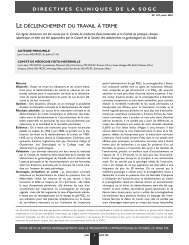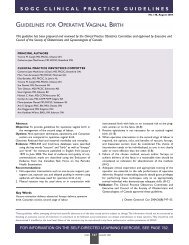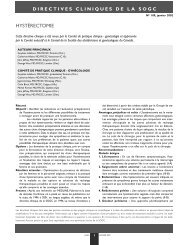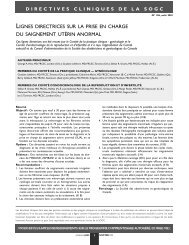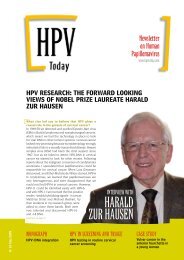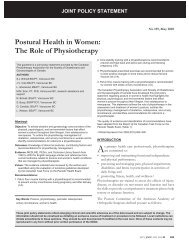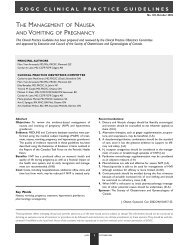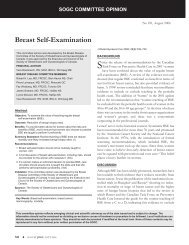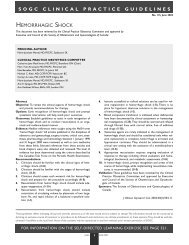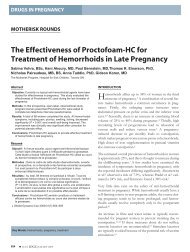Ultrasonographic Cervical Length Assessment in Predicting ... - SOGC
Ultrasonographic Cervical Length Assessment in Predicting ... - SOGC
Ultrasonographic Cervical Length Assessment in Predicting ... - SOGC
Create successful ePaper yourself
Turn your PDF publications into a flip-book with our unique Google optimized e-Paper software.
TRANSVAGINAL SONOGRAPHIC<br />
CERVICAL LENGTH ASSESSMENT IN<br />
ASYMPTOMATIC WOMEN WITH A<br />
HISTORY OF SPONTANEOUS PRETERM BIRTH<br />
<strong>Cervical</strong> length is a better predictor of preterm birth <strong>in</strong><br />
women at <strong>in</strong>creased risk, such as those with a history of<br />
spontaneous preterm birth, than <strong>in</strong> asymptomatic women<br />
at low risk. 35,49,87,91–95 In studies of women with a history of<br />
preterm birth, us<strong>in</strong>g a cervical length cut-off of 25 to 30 mm<br />
to predict preterm birth < 37 weeks of gestation, sensitivity<br />
is 60% to 80%, positive predictive value is 55% to 70%,<br />
and negative predictive value is 89% to 94%. Thus, a long<br />
cervix (at least 25 to 30 mm) is reassur<strong>in</strong>g and can help to<br />
reduce unnecessary and costly <strong>in</strong>terventions, such as activity<br />
restriction, maternal transfer, steroids, and tocolytics.<br />
A study published <strong>in</strong> 2009 found that the gestational age<br />
at which the prior preterm delivery occurred affects the<br />
frequency and rate of cervical shorten<strong>in</strong>g <strong>in</strong> the current<br />
pregnancy. A prior spontaneous early preterm birth (< 24<br />
weeks) puts women at a higher risk of cervical shorten<strong>in</strong>g.<br />
Women <strong>in</strong> this group also have a higher rate of cervical<br />
decl<strong>in</strong>e that beg<strong>in</strong>s at an earlier gestational age than women<br />
with a history of a later preterm birth (24 to 32 weeks). 96<br />
Summary Statement<br />
3. Transvag<strong>in</strong>al sonography can be used to assess the<br />
risk of preterm birth <strong>in</strong> women with a history of<br />
spontaneous preterm birth and to differentiate<br />
those at higher and lower risk of preterm delivery.<br />
The gestational age of a prior preterm birth affects<br />
the cervical length <strong>in</strong> a future pregnancy. (II–2)<br />
TRANSVAGINAL SONOGRAPHIC<br />
CERVICAL LENGTH ASSESSMENT IN<br />
OTHER ASYMPTOMATIC WOMEN AT HIGH RISK<br />
Transvag<strong>in</strong>al cervical length assessment has been found to<br />
be effective <strong>in</strong> predict<strong>in</strong>g preterm birth <strong>in</strong> asymptomatic<br />
high-risk groups, <strong>in</strong>clud<strong>in</strong>g those with uter<strong>in</strong>e anomalies, 97<br />
excisional cervical treatment for cervical <strong>in</strong>traepithelial<br />
neoplasia (LEEP and cone biopsy), 23,98 and prior multiple<br />
dilatation and evacuation procedures (beyond 13 weeks<br />
of gestation). 23,51,92,97–100 There is no evidence that cervical<br />
cerclage placement is beneficial <strong>in</strong> these women if they are<br />
found to have a short cervix on transvag<strong>in</strong>al ultrasound.<br />
Summary Statement<br />
4. <strong>Cervical</strong> length measurement can be used to identify<br />
<strong>in</strong>creased risk of preterm birth <strong>in</strong> asymptomatic<br />
women at < 24 weeks who have other risk factors<br />
for preterm birth (previous excisional treatment for<br />
<strong>Ultrasonographic</strong> <strong>Cervical</strong> <strong>Length</strong> <strong>Assessment</strong> <strong>in</strong> Predict<strong>in</strong>g Preterm Birth <strong>in</strong> S<strong>in</strong>gleton Pregnancies<br />
cervical dysplasia, uter<strong>in</strong>e anomaly, or prior multiple<br />
dilatation and evacuation procedures beyond 13<br />
weeks’ gestation). However, there is <strong>in</strong>sufficient<br />
evidence to recommend specific management<br />
strategies, such as cerclage, <strong>in</strong> these women. (II-2)<br />
DIAGNOSIS OF SHORT CERVIX BEYOND<br />
24 WEEKS’ GESTATION IN ASYMPTOMATIC<br />
WOMEN AT HIGH RISK<br />
The f<strong>in</strong>d<strong>in</strong>g of a short cervix <strong>in</strong> asymptomatic women<br />
at <strong>in</strong>creased risk of preterm birth can be divided <strong>in</strong>to 2<br />
categories accord<strong>in</strong>g to when the diagnosis is made: < 24<br />
weeks of gestation and ≥ 24 weeks of gestation. No<br />
randomized trials have evaluated specific management<br />
strategies for women at > 24 weeks with a short cervix;<br />
however, hav<strong>in</strong>g this <strong>in</strong>formation may help with empiric<br />
management of these women. This may <strong>in</strong>clude alter<strong>in</strong>g<br />
activity level, work, and travel, <strong>in</strong>creased surveillance,<br />
relocation close to a tertiary care centre, and adm<strong>in</strong>istration<br />
of corticosteroids.<br />
Summary Statement<br />
5. No specific randomized trials have evaluated any<br />
<strong>in</strong>terventions <strong>in</strong> asymptomatic women at > 24 weeks’<br />
gestation who are at <strong>in</strong>creased risk of preterm birth<br />
(e.g., those who have a history of prior spontaneous<br />
preterm birth, previous excisional treatment for<br />
cervical dysplasia, uter<strong>in</strong>e anomaly, or prior multiple<br />
dilatation and evacuation procedures beyond 13 weeks’<br />
gestation) and who have a short cervical length. This<br />
<strong>in</strong>formation may help with empiric management of<br />
these women, <strong>in</strong>clud<strong>in</strong>g reduction of activity level,<br />
work, or travel, relocation, <strong>in</strong>creased surveillance,<br />
and adm<strong>in</strong>istration of corticosteroids. (III)<br />
ULTRASONOGRAPHIC CERVICAL LENGTH<br />
ASSESSMENT IN CLINICAL MANAGEMENT<br />
<strong>Ultrasonographic</strong> <strong>Cervical</strong> <strong>Assessment</strong> <strong>in</strong> Women<br />
Suspected of Be<strong>in</strong>g <strong>in</strong> Preterm Labour<br />
The use of cervical length measurement has been studied<br />
<strong>in</strong> women present<strong>in</strong>g with suspected preterm labour. The<br />
goal of these studies was to attempt to differentiate between<br />
women who were likely to deliver preterm and those who were<br />
not. This <strong>in</strong>formation may help women avoid unnecessary<br />
<strong>in</strong>terventions of limited or unproven value, such as tocolysis,<br />
hospitalization, and activity restriction. Spontaneous preterm<br />
birth is unlikely if the cervical length is ≥ 30 mm. 39,101–103<br />
Fuchs et al. 104 showed that a cervical length of < 15 mm<br />
<strong>in</strong> a population present<strong>in</strong>g with pa<strong>in</strong>ful contractions (< 32<br />
MAY JOGC MAI 2011 l 491


